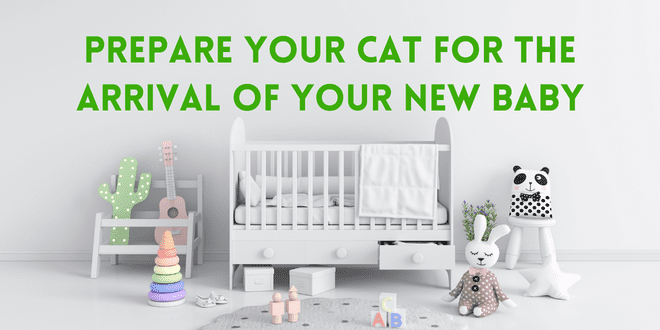
Cats are not big fans of change, so imagine how confusing it must be when there’s suddenly a new family member brought home. From the cat’s point of view this whole event takes place without any warning. Many people incorrectly assume any negative behavior a cat displays toward the new baby is based on jealousy but that’s not true. It’s really confusion. If you use your think like a cat mentality you realize the confusion caused by this major change in the cat’s normal routine and how much the environment suddenly becomes unfamiliar. The cat wakes up one day to discover a strange-smelling, strange-sounding creature has just landed in the territory. And what’s worse is, everyone suddenly starts acting all panicky and persists in shooing the cat away or yelling if kitty so much as attempts to approach this strange little hairless creature. Add to that, the fact no one seems to have time for the cat anymore. Much of the normal routine has been shifted.
The earlier you begin to ease your cat through the transition, the better it will be for all concerned. Here are some basics to get you started.
Your Cat Needs a Veterinary Check-up
Ensure your cat is current on vaccinations and gets a complete wellness exam. Address any chronic issues so your cat won’t be dealing with any pain or other medical issues. Take care of any parasite problems such as flea infestation. Take good care of your cat’s health to help protect from having stress taking a toll.
Maintain Your Cat’s Normal Schedule
A big mistake that many expectant parents make is to shower the cat with an incredible amount of attention BEFORE the baby’s birth because they know they’re not going to have the luxury of that much free time later. What ends up happening though is your cat gets comfortable with the increased amount of playtime, cuddle time, and attention but then when the baby comes, kitty’s whole world falls apart. Create a schedule before the baby’s birth that you’ll be able to maintain afterward.
Help Your Cat Get Comfortable With Sounds
Babies cry and sometimes those cries are mighty ear-shattering. Download sound effects of a crying baby or play those sounds on your smart speaker. Start by playing the sound at a very low volume while your cat engages in something positive such as interactive playtime or receiving yummy food. Gradually, in subsequent training sessions, increase the volume.
If your cat is very sound-sensitive, use a distraction tool that’s hard to resist, such as some Churu on a Lickimat. Churu is a highly palatable paste and the Lickimat is a rubber mat with soft, raised nubs where you embed the food. The cat is often easily distracted by licking the mat to get the yummy food. You can find both products at your local pet product store or online.
Babies aren’t the only ones capable of uncomfortable sounds. There are countless baby toys and equipment designed to entertain and stimulate baby by generating sounds. Exersaucers, bouncy swings, musical mobiles, rattles, electronic playtime mats – and the list goes on. If you know your cat is jumpy around certain types of noises or you just want to be extra careful by providing adequate time to adjust, purchase noise-generating baby equipment in advance to give kitty time to investigate. Periodically turn certain toys on or jiggle them so your cat gets used to all the new things. Keep treats with you so you’re ready to offer a reward to help create a more positive association.
Do You Know Any Friends With Babies?
If so, invite them over (one at a time) so your cat can begin to adjust to the actual sound, smell, and sight of what will be happening in the very near future. Don’t choose friends with toddlers. You want to expose your cat to a child who isn’t that mobile initially.
Respect Your Cat’s Nose
Allow your cat to investigate the new items you bring into the house as you prepare for the baby’s arrival. Your cat will want to sniff the crib, changing table, clothing, toys, etc. Let kitty do a scent investigation. If you sense they’re getting tense about any object coming into the house, distract them with a play session or offer a treat when they approach the object. Clicker training works well here. Click and reward for any neutral or positive behavior around the baby equipment or furniture. You can also take a clean sock, gently rub your cat around the mouth and then rub the corners of the furniture. Cats have scent glands on their cheeks that release pheromones (scent chemicals). The pheromones deposited during cheek-rubbing are friendly. Cats don’t typically cheek-rub objects unless they feel comfortable and secure. If you help your cat by doing some faux cheek-rubbing for them, you may help speed up the feeling of familiarity with the object. You can also use Feliway in the environment. This is a synthetic version of feline facial pheromones that your cat will interpret as their own. The product is available at pet product stores and online.
And While We’re on the Subject of Your Cat’s Nose
Start wearing baby powder and baby lotion. This may help later on because the baby will have a scent similar to yours.
Know the Facts About the Litter Box During Your Pregnancy
If you’re pregnant you have most likely been advised by your doctor to not handle litter box duties (some poorly-informed doctors or relatives may even advise you to get rid of your cat). This is due to the risk to the fetus from toxoplasmosis. While toxoplasmosis is certainly a danger, it’s important you know the accurate information. You are at more of a risk of getting toxoplasmosis from handling raw meat, not properly washing your hands, or from using the same cutting board for vegetables that you use for raw meat. You are also at risk from ingesting undercooked pork lamb or beef.
Some cats do carry toxoplasmosis but the ones most at risk are those who are allowed outdoors and as a result, hunt and ingest birds and rodents. Cats on raw food diets are also more at risk.
The reason pregnant women are advised not to handle litter box duties is that the oocysts are shed in the feces of the cat. The oocysts take 1-3 days before becoming infective once they are shed so you will greatly reduce your risk if the litter box is scooped on a regular basis. Another family member should handle the duties. If you absolutely must be the one to clean the litter, scoop twice a day, wear disposable gloves and then thoroughly wash your hands EVERY TIME.
You are also at risk of getting toxoplasmosis if you do outdoor gardening. Wear gardening gloves and wash your hands immediately afterward.
If you have questions on toxomplasmosis, talk to your doctor about all the precautions you need to take but there’s no reason to get rid of your cat. Common sense, protection, and good hygiene are what’s needed here. Your doctor knows your medical history and will advise you on safety procedures during your pregnancy.
Playtime is Valuable
Your cat needs to have a normal playtime schedule. Engage in at least two interactive play sessions a day. Do play sessions while the cat is in the presence of the baby to help form a positive association. Solo playtime is also important so your cat can have something fun to do while you’re feeding or interacting with the baby. Make the solo playtime fun– don’t depend on the basket of toys sitting in the corner. Those are boring! Place a fuzzy mouse in an empty tissue box or put a toy in a paper bag. Incorporate the use of puzzle feeders. If you don’t have a cat tree for your cat, this is the perfect time to get one so your cat can enjoy the view out the window.
Many cats enjoy watching the wildlife at the window. If you live in an area where there’s no access to watching birds at a feeder, or your cat hasn’t shown much of an interest, just turn the TV on YouTube and find a cat-interest video that showcases birds, insects, or little furry creatures. That should keep your cat focused while you tend to the baby. Follow that up with an actual play session with your cat or offer a puzzle feeder so they get to actually “capture” something.
If there are other family members in the home, enlist their help in keeping up with the cat’s playtime. If you’re alone, ask a friend (one the cat likes) if they can periodically come over and spend time playing with your cat or entertaining the baby while you do some playtime with your cat.
Crib Safety
Many new mothers are worried about whether the cat will jump in the crib. In reality, NOTHING should be in your child’s crib – not a blanket or stuffed toy. So if you’re concerned about the cat, invest in a crib tent.
When you set up the nursery and crib before the arrival of the baby, install the crib tent at that time as well so your cat never gets the opportunity to jump in there. Use a crib tent that’s domed shaped with a structured top and sides. This way, if the cat does try to jump up there’s no comfortable way to stay there and lounge. Keep the crib tent zipped up as soon as you put the crib together.
Baby Monitor
When the baby arrives, you’ll most likely have a baby monitor already in place. Most parents opt for a video monitor and that’s what I would recommend because it not only is the most accurate way to check on whether your baby is awake or asleep, you’ll also be able to see if the cat is in the nursery.
Do a Gradual Introduction
When the baby comes home, introduce your cat to the new family member gradually. Let your cat set the pace in terms of whether they even want to come closer. All interactions must be supervised but keep your demeanor low key and calm so you don’t alarm your cat. No matter how excited you are to have your cat and baby become friends, don’t force your cat to engage. If your cat feels they have a choice, they’ll be less stressed.
Need More Information?
For more information on cat behavior and training, check out the best-selling books by Pam Johnson-Bennett. Pam’s books are available at bookstores and online. We’ve also included Amazon links here on our website.
NOTE: If you have a question regarding your cat’s behavior or health, please contact your veterinarian. If you have questions about your pregnancy safety around your cat, talk to your doctor. This article is not intended as a replacement for your cat’s veterinary care. This article is for information purposes only and not offering medical advice or providing a medical diagnosis.

